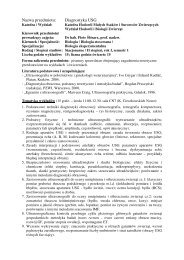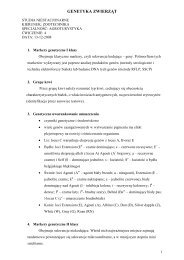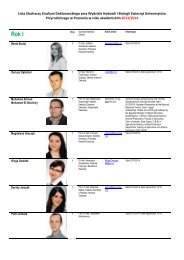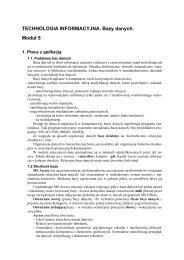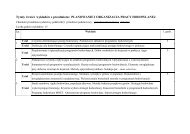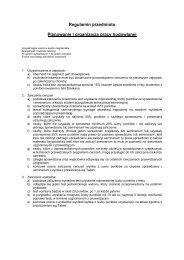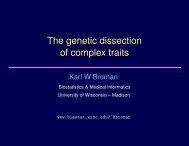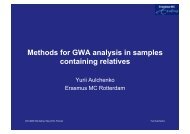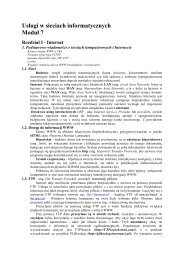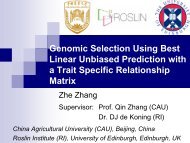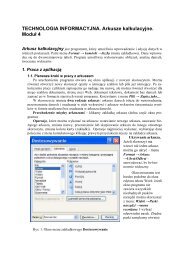The book of abstracts is available. - PoznaÅ
The book of abstracts is available. - PoznaÅ
The book of abstracts is available. - PoznaÅ
You also want an ePaper? Increase the reach of your titles
YUMPU automatically turns print PDFs into web optimized ePapers that Google loves.
14 th QTL-MAS Workshop, Poznań University <strong>of</strong> Life Sciences, Poland 2010Genetic architecture <strong>of</strong> yield and related traits in European maize: insightsinto the effects <strong>of</strong> linkage and allelic series. Consequences for markerass<strong>is</strong>ted selectionA. Charcosset 1∗ , G . Blanc 1 , Y.-F. Huan 1 , A. Galla<strong>is</strong> 1 , L. Moreau 11 INRA-CNRS-UPS-AgroPar<strong>is</strong>Tech Station de Génétique Végétale, Ferme du Moulon, 91190 Gif sur Yvette,France∗ Presenting author: Alain Charcosset, email: charcos@moulon.inra.frBackground. QTL mapping experiments conducted so far in plants generally consideredpopulations derived from the cross between two inbred lines. <strong>The</strong>y have proven efficient todetect QTL involved in trait variation. However, due to a limited number <strong>of</strong> effectiverecombination generations, they provide a poor resolution, with QTL confidence intervals<strong>of</strong>ten exceeding 20 cM for QTL <strong>of</strong> small effect and usual population sizes (between 100 or200 individuals). <strong>The</strong>y also address only a limited fraction <strong>of</strong> the genetic variability <strong>available</strong>in a breeding program. Alternative QTL experimental designs such as advanced intermatedpopulations or multiparental populations, have been proposed to overcome these drawbacks.Results. To evaluate the first strategy, we conducted a QTL detection experiment in (i) anadvanced intermated F 3 population <strong>of</strong> 322 lines and (ii) a conventional F 3 population <strong>of</strong> 300lines. Both were derived from the same parental maize inbred lines, with four additionalgenerations <strong>of</strong> intermating for (i), and jointly evaluated in testcross progeny for dry grainyield and related traits. QTL confidence intervals were on average 2.31 shorter in theintermated population than in the conventional population. However, fewer QTLs weredetected in the intermated population and less than 50% <strong>of</strong> the detected QTLs were commonto the two populations. Cross-validation showed that selection bias was more important in theintermated population. Results suggest that the a substantial fraction <strong>of</strong> the QTLs detected forGrain mo<strong>is</strong>ture at harvest and Grain Yield in the conventional population were actually due tocoupling phase between small effect QTL. Regarding the second strategy, we conducted aQTL detection experiment in six F2 populations (150 individuals each) derived from a halfdiallelbetween four European maize inbred lines. <strong>The</strong> joint analys<strong>is</strong> <strong>of</strong> the whole designincreased the power <strong>of</strong> QTL detection and its resolution. It revealed stronger ep<strong>is</strong>tatic effectsfor yield than for other traits. It also revealed allelic series with gradual effects for most QTLand allowed us to identify the parental origin <strong>of</strong> the most favorable alleles. Th<strong>is</strong> informationwas used to conduct rapid cycles <strong>of</strong> selection based only on marker evaluation. Phenotypicevaluation <strong>of</strong> plants selected at each generation showed a significant genetic gain throughcycles <strong>of</strong> selection. Interest <strong>of</strong> applying marker ass<strong>is</strong>ted selection to such multiparentaldesigns was further supported by simulations.Conclusions. <strong>The</strong>se results illustrate that yield related traits in maize have a complex geneticarchitecture, involving several tens <strong>of</strong> loci, linkage situations affecting apparent QTL effectsand possibly genetic variance, and allelic series with gradual effects. <strong>The</strong>y also show thatstrategies, such as genomic selection, addressing a broad diversity and using present highthroughputgenotyping technologies should prove highly beneficial to accelerate genetic gainfor such traits.40



